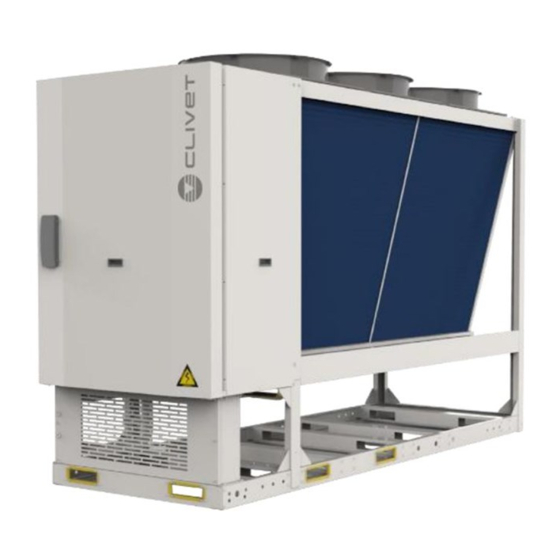
Table of Contents
Advertisement
Advertisement
Table of Contents

Summarization of Contents
General
Manual
Provides guidance for unit installation, use, and maintenance.
Preliminaries
Qualifies personnel for unit operation as per regulations.
Risk situations
Discusses unit design for safety and potential risks.
Intended use
Defines the unit's specific usage for cooling/heating water.
Breakdown/Malfunction
Instructs to disable unit and contact service.
Unit identification
Explains serial number label and its importance.
Type of refrigerant R32
Details R32 refrigerant characteristics like GWP and flammability.
Positioning
Installation
Covers unit placement according to local regulations and environmental factors.
Functional spaces
Explains the purpose of functional spaces for operation and maintenance.
Installation standards
Lists requirements for installing units, including elevation and snow accumulation.
Water Connection
Hydraulic system
Guidelines for designing pipes to minimize pressure drops for optimal performance.
Water quality
Covers checking water quality and its impact on performance and corrosion.
Risk of freeze
Advises on protecting the unit from freezing.
Water filter
Details filter specifications and installation requirements.
Domestic hot water
Explains the DHW option, 3-way valve, and priority management.
Unit in modular configuration
Covers modular system setup, master/slave configuration, and limitations.
Electrical Connections
Electrical lines
Requirements for electrical lines, determined by specialized personnel.
Electrical data
Explains where to find unit electrical data and its sources.
Signal s / data lines
Guidelines for laying out signal and data lines to avoid interference.
Connections by the Customer
Details customer connections for relays, sensors, and pumps.
Remote control
Explains remote control operation and settings.
Unit in modular configuration
Covers setting date/time and enabling multiple configurations.
Modbus
MODBUS
Overview of Modbus communication and reading/writing capabilities.
Communication spec:RS-485
Specifies communication parameters for RS-485.
Reading and writing register
Detailed list of Modbus registers for reading and writing.
Status query register
Table of Modbus registers for querying unit status.
Fault Code
Lists fault codes and their decimal equivalents for BMS reading.
Start-Up
Preliminary checks
Lists essential checks before unit startup.
Start-up sequence
Step-by-step guide for unit startup operations.
Refrigerant circuit
Checks for the refrigerant circuit before startup.
Water circuit
Checks for the water circuit before startup.
Electrical circuit
Checks for grounding, conductor tightening, and phase unbalancing.
Units in multiple configuration
System management by master unit and sequential unit activation/deactivation.
Control
Set MODE and TEMPERATURE
Guide to setting the operating mode and temperature.
USER MENU - QUERY
How to query unit data in a networked system.
USER MENU - TIMER
Accessing timer settings.
USER menu - DOPPIO SETPOINT
Enabling or disabling double setpoint functionality.
USER menu - TEMPERATURE COMPENSATION
Accessing and adjusting temperature compensation settings.
USER MENU - DOMESTIC HOT WATER
Settings for domestic hot water operation.
Troubleshooting
Alarm reset
Instructions for resetting alarms and identifying causes.
The unit is in protection in the following conditions
Lists specific conditions causing unit protection.
Error code
Table of error codes, descriptions, and troubleshooting steps.
Maintenance
SAFETY WARNINGS FOR OPERATIONS ON UNITS CONTAINING R32
General safety precautions for R32 units.
Leak detection methods
Acceptable methods for detecting flammable refrigerant leaks.
Removal and evacuation
Procedure for refrigerant removal and evacuation.
Recovery
Safe practices for refrigerant recovery.
Inspections frequenty
Recommended inspection frequency based on usage and environment.
Water exchanger
Importance of clean exchanger surfaces and cleaning procedures.
Decommissioning
Disconnection
Steps before disconnecting the unit, including recovering fluids.
WEEE INFORMATION
Information on WEEE regulations and proper disposal of electrical equipment.
Residual Risks
Installation
Risks from incorrect installation like leaks or electric shock.
Electric parts
Risks associated with electric connections and components.
Refrigerant
Risks associated with refrigerant expulsion and contact with heat sources.
Dimensional drawings
Size 18.2 - 20.2
Dimensional drawings and specifications for specific unit sizes.
Size 25.2 - 30.2 - 35.2
Dimensional drawings and specifications for larger unit sizes.
General technical data
Performance
Table of heating and cooling performance data by size.
Compressor
Technical specifications for compressors.
Water circuit
Technical data related to the water circuit.
Admissible water flow rates
Table of admissible water flow rates by unit size.
Sound levels
Standard Mode
Sound levels for standard operating mode.
Silenced Mode
Sound levels for silenced operating mode.
Operating range
Operating range - Cooling
Graphical representation of operating ranges for cooling.
Operating range - Heating
Graphical representation of operating ranges for heating.















Need help?
Do you have a question about the WSAN-YES 25.2 and is the answer not in the manual?
Questions and answers